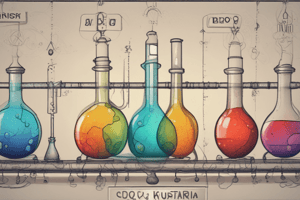Podcast
Questions and Answers
What is the definition of an acid according to the Arrhenius Theory?
What is the definition of an acid according to the Arrhenius Theory?
- A substance that releases OH- ions
- A substance that forms a salt
- A substance that donates a proton (correct)
- A substance that accepts a proton
What is the pH of a neutral solution?
What is the pH of a neutral solution?
- pH 14
- pH 7 (correct)
- pH 0
- pH 1
Which of the following is an example of a strong acid?
Which of the following is an example of a strong acid?
- HF
- CH3COOH
- HCl (correct)
- NH3
What is the purpose of an acid-base indicator?
What is the purpose of an acid-base indicator?
According to the Bronsted-Lowry Theory, what is a conjugate acid?
According to the Bronsted-Lowry Theory, what is a conjugate acid?
What is the formula for pH?
What is the formula for pH?
What type of reaction occurs between an acid and a base to form a salt and water?
What type of reaction occurs between an acid and a base to form a salt and water?
Which of the following is an example of a weak base?
Which of the following is an example of a weak base?
Flashcards are hidden until you start studying
Study Notes
Arrhenius Theory
- Acids: substances that donate a proton (H+)
- Bases: substances that accept a proton (OH-)
Bronsted-Lowry Theory
- Acids: substances that donate a proton (H+)
- Bases: substances that accept a proton
- Conjugate acid: the species formed when a base accepts a proton
- Conjugate base: the species formed when an acid donates a proton
pH Scale
- Measures the concentration of hydrogen ions (H+) in a solution
- pH = -log[H+]
- pH 7: neutral (neither acidic nor basic)
- pH < 7: acidic
- pH > 7: basic
Strong and Weak Acids and Bases
- Strong acids: completely dissociate in water, releasing all H+ ions
- Examples: HCl, HNO3, H2SO4
- Weak acids: partially dissociate in water, releasing some H+ ions
- Examples: CH3COOH, HCN, HF
- Strong bases: completely dissociate in water, releasing all OH- ions
- Examples: NaOH, KOH, Ca(OH)2
- Weak bases: partially dissociate in water, releasing some OH- ions
- Examples: NH3, CO3^2-, PO4^3-
Acid-Base Reactions
- Neutralization: reaction between an acid and a base to form a salt and water
- Example: HCl + NaOH → NaCl + H2O
- Acid-base equilibrium: balance between the forward and reverse reactions
- Example: HCl + H2O ⇌ H3O+ + Cl-
Acid-Base Indicators
- Substances that change color in response to changes in pH
- Used to determine the pH of a solution
- Examples: litmus, phenolphthalein, methyl orange
Arrhenius Theory
- Acids are defined as substances that donate a proton (H+)
- Bases are defined as substances that accept a proton (OH-)
Bronsted-Lowry Theory
- Acids are defined as substances that donate a proton (H+)
- Bases are defined as substances that accept a proton
- Conjugate acid is the species formed when a base accepts a proton
- Conjugate base is the species formed when an acid donates a proton
pH Scale
- Measures the concentration of hydrogen ions (H+) in a solution
- Calculated using the formula: pH = -log[H+]
- pH 7 is neutral, meaning neither acidic nor basic
- Solutions with pH < 7 are acidic
- Solutions with pH > 7 are basic
Strong and Weak Acids and Bases
- Strong acids completely dissociate in water, releasing all H+ ions
- Examples: HCl, HNO3, H2SO4
- Weak acids partially dissociate in water, releasing some H+ ions
- Examples: CH3COOH, HCN, HF
- Strong bases completely dissociate in water, releasing all OH- ions
- Examples: NaOH, KOH, Ca(OH)2
- Weak bases partially dissociate in water, releasing some OH- ions
- Examples: NH3, CO3^2-, PO4^3-
Acid-Base Reactions
- Neutralization reactions occur between an acid and a base to form a salt and water
- Example: HCl + NaOH → NaCl + H2O
- Acid-base equilibrium is the balance between the forward and reverse reactions
- Example: HCl + H2O ⇌ H3O+ + Cl-
Acid-Base Indicators
- Are substances that change color in response to changes in pH
- Used to determine the pH of a solution
- Examples: litmus, phenolphthalein, methyl orange
Studying That Suits You
Use AI to generate personalized quizzes and flashcards to suit your learning preferences.




